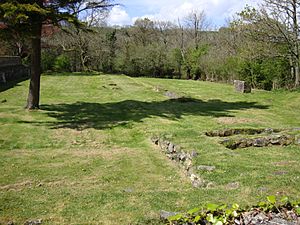Whitland Abbey facts for kids
Whitland Abbey was a special place in Wales. It was once a country house and later became a Cistercian abbey. A Cistercian abbey is a type of monastery where monks live, pray, and work together. This abbey was located in Carmarthenshire, and the nearby town of Whitland is named after it.
The abbey was also known as Ty Gwyn ar Daf. This Welsh name means "White House on the Taf." It got this name because there was a white house here before the monastery was built. Whitland Abbey is famous because it's where Hywel Dda, a powerful Welsh king, created his laws around the year 940. The abbey worked as a Cistercian monastery from the 12th century until the 16th century.
Contents
History of Whitland Abbey
The White House on the Taf
The place called Ty Gwyn ar Daf was sometimes used by King Hywel Dda in the 10th century. Around the year 940, a very important meeting was held here. King Hywel Dda and his wise men gathered to write down a set of laws for Wales. These laws are still known today as "the Laws of Hywel Dda."
To make this meeting extra special, the king and his court stayed at Ty Gwyn ar Daf during Lent. They spent this time in prayer and devotion. This was to ask for divine wisdom to help them create good laws. After they were written, Hywel's laws were kept safe at Dinefwr Castle.
Founding the Abbey
Whitland Abbey was officially started on September 16, 1140. Monks from a famous monastery called Clairvaux Abbey in France came to set it up. At first, the abbey was located in a different place, near Haverfordwest. But around 1155, it moved to its current spot in Whitland. A man named John of Torrington gave them the land for the new site.
Whitland Abbey became very important for setting up other monasteries in Wales. For example, monks from Whitland helped found Strata Florida Abbey in 1164. They also helped start Strata Marcella Abbey in 1170 and Cwmhir Abbey in 1176.
Important Welsh Connections
Even though Whitland Abbey was first started by a Norman family, it soon came under the care of Rhys ap Gruffudd. He was a powerful Welsh prince of Deheubarth. The abbey became a strong supporter of the Welsh people in their fight to stay free from English rule.
There's a story about Cadwaladr, who was the brother of Owain Gwynedd, another Welsh prince. Cadwaladr had built a new castle called Cynvael Castle. During a disagreement with his nephews, he trusted the abbot (the head monk) of Ty Gwyn ar Daf to look after his castle. The abbot and his men bravely defended the castle against the young princes who attacked it. They fought hard until the castle walls were broken down. The abbot managed to escape from the ruins with help from some friends. He then returned safely to his monastery.
Rhys ap Gruffudd's son, Maredudd, also became a monk at Whitland. He chose to live out his days there after he had been blinded by order of King Henry II of England.
The End of the Abbey
Whitland Abbey was dedicated to St Mary and had about eight monks living there. It continued to be a successful and important place until the time of the dissolution. The dissolution was when King Henry VIII closed down many monasteries in England and Wales in the 16th century. At that time, the abbey's income was recorded as being about £153. This was a lot of money back then. In 1544, the land where the abbey stood was given to Henry Audley and John Cordel.
Later, a metalworking factory called a forge was built on the site. People say it was the oldest forge in Carmarthenshire. A Victorian house was also built there. Over time, the land and buildings changed hands many times through families like the Yelvertons and Blakes. Eventually, in 1951, the estate was sold off in pieces to local farmers.
Today, you can't see much of the old royal palace of Ty Gwyn. It was a smaller building, mostly used for hunting. Only the grass-covered outlines of its old walls can be seen.



